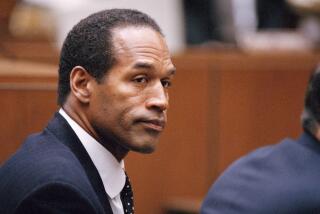Pilate, the Jews and Jesus
- Share via
Despite more than 30 years of efforts by churches to disavow anti-Jewish readings of the New Testament, statements by two American basketball stars and an Arab president are disturbing evidence that the message still has trouble getting through.
First, two New York Knicks stars, observed by a newspaper reporter during a recent team Bible study, said Jews had the blood of Christ on their hands.
Then, this week, Syrian President Bashar Al-Assad welcomed Pope John Paul II to Damascus with a blistering condemnation of Jews, accusing them of murdering and torturing Palestinians--just as, he charged, they had betrayed and tortured Jesus.
Assad’s comments were denounced by Israel and the Anti-Defamation League in the United States as a “diatribe” with an obvious political agenda.
“This is rhetoric that is radioactive,” said Rabbi Abraham Cooper, associate dean of the Simon Wiesenthal Center in Los Angeles. “This kind of invective doesn’t wash away. It’s the kind of invective that is used to prepare populations for war, not for coexistence.”
More vexing in many ways were the statements of Knicks players Charlie Ward and Allan Houston, two practicing Christians, quoted in the April 22 issue of the New York Times Magazine, which profiled the team.
As the players talked to the writer of the article during a Bible study session, Ward said, “Jews are stubborn. But tell me, why did they persecute Jesus unless he knew something they didn’t want to accept?” He then said, “They had his blood on their hands.”
Houston was then quoted as saying, “Then they spit in Jesus’ face and hit him with their fists,” referring to an excerpt from the book of Matthew in the New Testament.
Declared the Anti-Defamation League: “We had thought these destructive historic myths, which have been a source of anti-Semitism for centuries, were a thing of the past.”
That some Christians continue to blame all Jews--then and now--for the death of Jesus 2,000 years ago is a subject that continues to gnaw at the conscience of other Christians and that engenders frustration and dread among Jews.
“It tells us we continue to have a very important task in front of us,” said New Testament scholar and Los Angeles Episcopal Bishop Frederick H. Borsch. “One of the central tasks for Christianity is to turn away from any kind of history in its past which has been anti-Semitic, or allows that to be promoted in any way.”
It isn’t as if the church hasn’t tried.
Most famously, the Roman Catholic Church issued a declaration in 1965, known as Nostra Aetate, which declared that neither all Jews indiscriminately in Jesus’ time, nor Jews today, could be charged with his death. That implicitly shifted responsibility to the sinful nature of all humanity.
During his pontificate, John Paul has repeatedly sought reconciliation between Jews and Christians. Anglican and Protestant churches have also issued unambiguous apologies to Jews and declarations against anti-Semitism since at least 1964.
More recently, authors of novels and biographies about Pontius Pilate, the Roman governor who ordered Jesus’ crucifixion, have attempted to place the role of Jews in a historical context.
Pilate Is Ultimately to Blame, 2 Authors Say
The blame for Jesus’ death, two authors write in recent books, ultimately rests on Pilate’s shoulders. Despite accusations of heresy against Jesus lodged by the Sadducees--the Jewish priestly class--Jesus was ultimately executed by Romans on charges of sedition, a political crime.
“Under Roman rule, the Sanhedrin [Jewish supreme court] had ceded to [Pilate] all power of life and death. They could pass sentence in a capital case, but they could not carry the sentence out,” Ann Wroe writes in her historical biography “Pontius Pilate.”
James R. Mills, the author of a fictional account of the arrest, trial and execution of Jesus, agrees. In his “Memoirs of Pontius Pilate,” he clearly sees politics at work.
He should know. He is a former president pro tempore of the California Senate and a nominal Protestant who for many years attended American Baptist churches. He was fascinated by the idea of looking at the Crucifixion through the eyes of Pilate, a political pragmatist.
In a word, Mills said, the Jews were in a difficult situation. Their country was under military occupation by Rome. Pilate had appointed the chief priest, Caiaphas. So long as the Jews did not rock the boat, Mills said, Rome allowed them certain freedoms and discretion.
Caiaphas’ fear, Mills said, was that despite Jesus’ protestations to the contrary, Jesus would foment an uprising, as had others before him who claimed to be the Messiah. That, Caiaphas worried, would bring the full force of the Roman government down on the entire country. Better for one Jew to die for the people than a whole nation perish, Caiaphas says in John 11:50.
Pilate, meanwhile, had his own political problems. His mentor, Lucius Aelius Sejanus, and his family had already been put to death in Rome by Tiberius Caesar. Sejanus was the commander of the Praetorian Guard who once ruled on behalf of the emperor. Now Sejanus’ enemies were looking to get rid of Pilate.
Mills said Pilate could not afford to alienate Caiaphas--his chief ally among the Jews--or be seen by Rome as allowing a potential revolutionary to go free.
Says Pilate during a fictional commentary in Mills’ book: “Sejanus was gone, and his enemies were influential in Rome, and I could preserve myself only by suppressing any and all debate as to whether or not I was protecting the interests of Caesar and of Rome. Even though I knew that poor carpenter [Jesus] was no threat to the peace of the province, I had been put on notice that releasing him would be a threat to my own peace, to say the least.”
Mills and Wroe, in her more detailed and scholarly biography, draw on such non-Christian historical sources as Josephus Flavius, a Romanized Jew who wrote 40 years after Pilate was recalled from Judea, and Philo of Alexandria, a Jew and one of Pilate’s contemporaries.
Mills does not suggest that Jews were not involved in Jesus’ death. But he limits their culpability to the Sadducees, the priestly class. Most Jews, Mills adds, were followers of the Pharisees, the forbears of modern rabbinical Judaism.
Mills faults the Gospel writers for not making that distinction clear. “It’s a pity they didn’t say ‘Sadducees,’ ” he said. Instead, the accounts can easily be misread to refer to all Jews. He noted that Jesus and his followers were Jews.
The Sadducees, Mills notes, disappeared from Jewish life 37 years after the Crucifixion when the second Temple was destroyed by the Romans in AD 70.
Idea Was ‘Sadly Put in Place by the Church’
Rabbi Cooper finds even that distinction problematic. The Jews “were under occupation,” he said. “The whole idea of splitting responsibility for the death between a religious group that is no longer around [Sadducees] and what was the mainstream of the teachers [Pharisees] kinds of begs the issue. The point is that the Jewish people of that time in history were not empowered to kill anyone.”
(Mills said Jews could hand down a sentence of death by stoning in cases of heresy. Wroe said that the Sanhedrin had a kind of “lynch power” but that a proper judicial death sentence required Pilate’s permission.)
The notion of Jewish responsibility was “sadly put in place by the church historically,” Cooper said. “It has made its way into the public domain in nationalism and, beyond the Industrial Revolution, it transmuted into racism.”
Mills said one of his reasons for writing the book “was to try to counter anti-Semitism, which stems from a superficial reading of the Gospels. By reading the Gospels analytically, the Jews as a people are exonerated.”
Ultimately, however, theology must be the corrective, said Bishop Borsch.
“The danger is still there,” he said. “I don’t think the history is bad. But we have to go to the root of it and say historically it was true. Jesus was put to death in a certain kind of context and situation. But it isn’t a question in Christian theology that a religious group [Jews] put Jesus to death, but a human group put him to death.”
Borsch noted, as he has in the past, that Christians sing a hymn that has it right. The lyrics, he said, ask and answer the question: “Who was it, Lord, that crucified thee? I crucified thee!”
More to Read
Sign up for Essential California
The most important California stories and recommendations in your inbox every morning.
You may occasionally receive promotional content from the Los Angeles Times.










